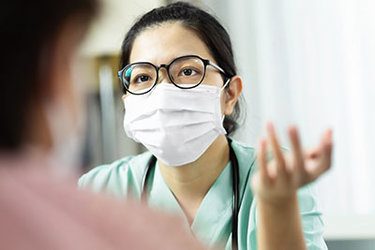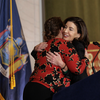State’s vaccination plan released
— Photo from the Centers for Disease Control and Prevention
Once there is a vaccine for COVID-19, the first New Yorkers to receive it will be health-care workers in patient-care settings as well as long-term-care facility workers, and the at-risk patients in those facilities, according to the state’s plan released on Sunday.
ALBANY COUNTY — The county had an increase of 16 COVID-19 cases overnight as Governor Andrew Cuomo held a press conference in Albany on Sunday to announce the state’s plan for distributing vaccines, once they are available.
Also, Cuomo announced that New York ski resorts will be allowed to open on Nov. 6 with indoor capacity at 50 percent and social distancing on the slopes.
States were required to submit their vaccination plans by Friday, Oct. 16, to the Centers for Disease Control and Prevention.
“This is going to be a massive undertaking — hospitals, urgent-care facilities, primary-care facilities, pharmacies, local departments of health, mobile units, mass vaccination sites ….,” said Cuomo at Sunday’s briefing. “The federal government is in charge of producing the actual vaccines and distributing the vaccines so the state’s position is we have to wait for the federal government to provide us the vaccines, what is the schedule, how many, etcetera.”
Cuomo, who chairs the National Governors Association, noted he had asked to meet with President Donald Trump “to discuss how this is supposed to work between the federal government and the states.”
On Sunday, the association sent a letter to the White House compiling into 36 questions information governors across the nation are asking.
Summarizing the questions, Cuomo said, “How will the vaccine be allocated to states? What formula is used — in other words, are you going to allocate it by infection rate? Are you going to allocate it by number of cases of COVID? Are you going to allocate it by population? Who determines how many each state gets — what’s the basis that you are using?”
Cuomo also said it is important to know if there is a national strategy on prioritizing the shots — for example, vaccinating nursing homes, or nurses, or doctors, or people over age 70 ahead of others.
Coumo noted that some of the vaccines under development require two doses, which means New York State would have to administer 40 million shots. To put that number in perspective, he said, “Seven months it took us to do 12 million tests. How long is it going to take to do 40 million vaccinations? Or 20 million vaccinations?”
Cuomo also said, “There’s going to be trust issues about the vaccination, and there’s going to be conspiracy theories, and there are going to be rumors and there’s not a lot of trust, let’s be honest, in the federal health organizations right now, and, before people let you put a needle in their arm and inject something, there are going to be serious questions ….”
New York State has a task force of experts that are to review any vaccine before Cuomo recommends it to the public. “I think that will give people added surety in the vaccine,” he said.
Finally, Cuomo raised the issue of paying for the vaccines. “New York State is already $50 billion in debt between state and local governments,” he said. “And they have not passed legislation on the state and local relief. If the state has a deficit and the local governments have a deficit, we can’t fund essential workers.”
He said the vaccination program will require more, not fewer, essential workers.
Cuomo went on, “Who pays? Insurance companies? What happens for the uninsured people? How do I keep dosages cold, at negative 80-degrees? … That’s the difference between life and death in a situation like this. And that’s where we have to get.”
New York’s plan
The state’s 90-page plan puts high-risk populations and essential health-care workers in high COVID-19 zones as the first priority, followed by those same two groups in low-prevalence zones.
The third priority is lower-risk populations and other essential workers in high COVID-19 zones followed by those same groups in low-prevalence zones.
The fifth priority is the general population in high COVID-19 zones followed by the general population in low-prevalence zones.
The plan also outlines five phases of administering vaccines. The first phase is for health-care workers in patient-care settings, long-term-care facility workers, and the at-risk long-term-care facility patients.
The second phase is for first responders, teachers and school staff, public-health workers; other essential frontline workers like pharmacists, grocery-store workers, and transit employees; other long-term-care facility patients; and people with high-risk health conditions.
The third phase is for people over age 65 or people younger than 65 with high-risk health conditions.
The fourth phase is for all other essential workers and the fifth phase is for healthy adults and children.
The plan also outlines measures to train, register, deploy and support providers to administer the vaccine and a data and technology infrastructure to coordinate and monitor all aspects of the procame.
Additionally, the state’s plan covers an education and community outreach campaign to build trust and inform the public as well as a budget and procurement process to get needed equipment and supplies.
Ski resorts to open
Besides requiring ski lodges to run at 50-percent capacity, the state guidance for resorts to open requires masks to be worn except when skiers are eating, drinking, or skiing. Only people in the same party are to share a lift or gondola. And ski classes are limited to 10 people.
Also, all rented equipment is to be disinfected between uses. Food and beverage and retail services must follow state-issued guidance. And the outdoor capacity on ski slopes is to be reduced by 25 percent during peak days or if multiple trails are closed.
Word play
In a playful moment, Cuomo spoke at his press conference on Sunday about new words that have been coined in the wake of the pandemic.
He started by asking, “Do you know what VAP means? No. OK, so we go to the semi-official post-COVID-19 dictionary, because there are new words and terms that have been used post-COVID that didn’t exist, or words that existed pre-COVID but have a different meaning post-COVID.”
VAP stands for the Vaccine Administration Program, the state’s new plan.
Cuomo went on to name other “post-COVID terms” in this mythical dictionary: “Blursday, when all the days of the week start to blur together, so you just become Blursday and you don’t have a Wednesday, you don’t have a Thursday.
“COVID 15, the weight gain by stress boredom eating during the pandemic, can be COVID 15. There’s also COVID 20, there’s COVID 25 ...
“Herd immunity. Two types of herd immunity, you have to be careful when people say herd immunity. One type is … herd immunity, h-e-r-d, when enough people are immune from the virus that the community becomes immune. There’s h-e-a-r-d, heard immunity, when someone mistakenly believes they’re immune because someone told them that they’re immune. ‘I heard that they’re immune.’ Two different immunities.”
At a press briefing earlier this week, Cuomo had added “micro-cluster” to the mythical post-COVID-19 dictionary. That’s the term he uses to describe the red zones where there have been outbreaks of COVID-19 and restrictions are immediately put in place to contain the outbreak.
Newest numbers
Cuomo reported on Sunday that rate of positive test results in the downstate red zones was 3.19 percent. The rest of the state had a 1-percent positivity rate. The state’s overall positivity rate — including the red zones — was 1.08, Cuomo said.
The Capital Region, of which Albany County is a part, had a rate of 0.9 percent. Six of the state’s 10 regions were above the target of 1 percent.
In Albany County, as of Sunday morning, the number of confirmed COVID-19 cases was 3,303, according to a release from Albany County Executive Daniel McCoy.
Of the 16 new cases, six had close contact with someone infected with the disease, one is a health-care worker or a resident of a congregate setting, and nine did not have a clear source of infection detected at this time.
Currently, 1,073 Albany County residents are under quarantine, up from 1,058. The five-day average for new daily positives decreased to 19.6 from 20. There are now 105 active cases in Albany County, down from 111 yesterday.
So far, 14,561 county residents have completed quarantine. Of those, 3,198 had tested positive and recovered.
Twelve county residents are hospitalized with COVID-19, up from nine on Saturday. One patient is in an intensive-care unit. The county’s hospitalization rate has increased to 0.36 percent from 0.30 percent.
Albany County’s COVID-19 death toll remains at 136.


